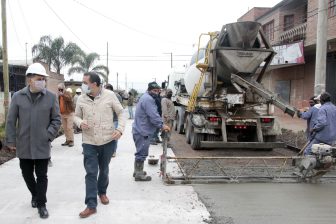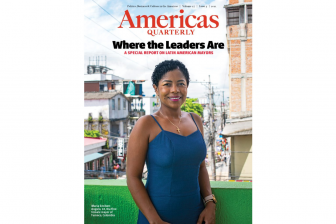Since taking office in 2018, Cuba’s President Miguel Díaz-Canel has aspired to be the Fidel Castro of the 1980s, abandoning the more recent reform approach taken by the younger Raúl Castro and doubling down on the worst of the regime’s autocratic traditions – with few innovations.
What Díaz-Canel likely did not expect was that applying Fidel Castro’s recipe in the 21st century would backfire – like it did this month and will continue to.
Cuba’s society, after all, is markedly different today. The new generation has gained little, if anything, from the revolution. It is also far more globalized, more appreciative of ties with foreigners, more internet-connected, and, perhaps most important, less fearful.
July’s protests, the largest in decades, raised the question of what causes uprisings in authoritarian contexts. Did they occur because the regime relaxed a bit, offering new opportunities for disaffected groups to mobilize? Or because the regime hardened political restrictions, causing civil society to protest in a desperate gasp for air?
Cuba’s case confirms the latter thesis resoundingly. The protests occurred not because the regime was giving citizens greater spaces, but precisely because it was taking them away. It would be a mistake for Cuban leaders to believe that further restrictions will solve the unrest.
Protests everywhere are always driven by grievances, and in Cuba there are plenty. But in authoritarian contexts, protests are also driven by changes in regime characteristics. Sometimes, as in the Soviet bloc and China in the late 1980s, upheavals occur because leaders introduce liberalizing reforms that lead to rising expectations and civic mobilizations.
At first glance, there is some evidence of regime relaxation. Under Díaz-Canel’s watch, the state approved a new constitution that guarantees the right to public demonstration and legalizes the private sector. The state also approved the spread of internet access, and earlier this year relaxed economic restrictions affecting the self-employed sector.
However, these steps forward pale in comparison to the many steps backward.
Cuba’s autocratic backsliding began as soon as Díaz-Canel took office. In 2018 the president issued the infamous Decree 349, mandating the culture ministry’s approval for both public and private cultural events and banning the use of unpatriotic symbols. This was the most serious crackdown on what had been the most open sector of Cuban society since the 1990s, the artistic community.
In 2019, Díaz-Canel began to restrict the very same online freedoms he had granted. He passed Decree Law 370, prohibiting Cubans from storing their information on foreign servers, a necessity for Cuba’s small, illegal independent press. Decree Law 389, passed the same year, allowed for government electronic surveillance without warrant and for any evidence gained that way to be admissible in court.
And while some have touted the constitution’s more liberal provisions, the final draft adopted reforms that were far more modest than the original plan. Ultimately, the one-party state was reaffirmed. The word communism was reintroduced. And nothing was done to change the intensely repressive Penal Code of 1987.
That penal code openly bans freedom of association and expression (Articles 208 and 103). More so than the Constitution, it is the penal code that governs police activity and court rulings. Cuba’s police, incidentally, is itself an organization modeled after East Germany’s efficiently vicious security police, the Stasi.
Back to the 20th century
The government up to this year was also essentially backtracking on Cuba’s broadest reforms announced by Raúl Castro in 2011, the so-called Lineamientos. Claiming there had been errors in Raúl’s reforms, Díaz-Canel introduced a plethora of tough regulations in 2018 aimed at curtailing the growth of the self-employed.
The Díaz-Canel regime also backtracked on LGBTQ rights. Under his predecessor Raúl Castro, Cuba made some headway as Raúl’s daughter, Mariela Castro, led an official Center for Sexual Education that supported the expansion of LGBT rights. Díaz-Canel, in contrast, partnered with religious leaders to block a constitutional amendment on behalf of same-sex marriage and in 2019, with Mariela’s support, the government canceled Cuba’s Pride parade and cracked down on those who tried to hold an alternate march. Despite all the pinkwashing the regime tries to do, LGBT Cubans continue to report being fired, excluded or attacked for their identities, and Cuban police routinely ignore anti-LGBT crimes.
And where the pandemic should (and initially did) provide an opportunity for the nation with the most doctors per capita to reassure its population, Díaz-Canel soon started using pandemic guidelines as an excuse to crack down on opposition figures. He charged peaceful demonstrators, dissidents, and activists with breaking Covid-19 safety guidelines when no other charges could be found. Freedom House, an organization that monitors liberties, lowered Cuba’s already low score during the pandemic due to increased suppression.
This all came with little surprise. Before he was appointed to the presidency, a 2017 video was leaked of Díaz-Canel in a closed-door meeting with communist officials, where he criticized the Obama-Raúl thaw and espoused hardline views on dissent. He even called for censoring the press – a sign that a Fidel-style government was looming.
But Díaz-Canel is not only re-autocratizing Cuba, he is also reinforcing Cuba’s system of white supremacy. Although the Black Lives Matter movement in the United States issued a statement blaming the U.S. embargo rather than the Cuban government for the July uprising, the truth is that the Cuban regime upholds many of the pillars of white supremacy that BLM is combatting.
While Black Cubans are well represented in the National Assembly, this body has almost no power. It meets only two times a year and essentially rubber-stamps what comes from the top.
Real power resides in the president and his close advisors. The vast majority have always been white. And this clique has reinforced an economic system that is overtly anti-Black.
Racial wealth disparities are vast. White Cubans are five times more likely than Black Cubans to have a bank account. White Cubans control 98% of Cuban private businesses. The only form of private financing the government allows is remittances, and yet, whites receive 78% of them. Over two-thirds of black and mixed-race Cubans are still without internet access. Black and mixed race Cubans have been excluded from most high positions in the public sector.
Perhaps the only arena in which Afro-Cubans have been able to establish any sort of influence is within the independent artistic and cultural sector. This is the sector that Díaz-Canel has targeted directly with his Decree 349.
Rather than going the way of the Soviet Union’s Mikhail Gorbachev, who ushered in a period of political and economic liberalization in the 1980s, Díaz-Canel is copying Fidel Castro’s reaction in the same period. In the 1980s, Castro so feared the implications of a similar moment in Cuba that he decided to move counterclockwise by imposing the so-called Rectification Campaign, featuring some of the most draconian restrictions in the Soviet bloc at the time. The deaths by firing squad of four highly-decorated Cuban military officers in 1989, on questionable charges of treason, were the most open manifestation of Fidel’s panic-rage of the era.
Díaz-Canel’s intransigence is not exactly a replica of the past. He has updated some aspects of the fidelista model. For instance, long-term imprisonment has been replaced with shorter-term arrests. But make no mistake about it: Open political dissent remains a crime, and more than 30,000 people have been detained in the past five years, even if their time in custody is shorter.
If the regime doesn’t move to reverse Díaz-Canel’s autocratization, Cubans will continue to say, ¡se acabó!
—
Corrales is the Dwight W. Morrow 1895 Professor of Political Science at Amherst College in Amherst, Massachusetts. Scott Brasesco is a senior at Amherst College.






